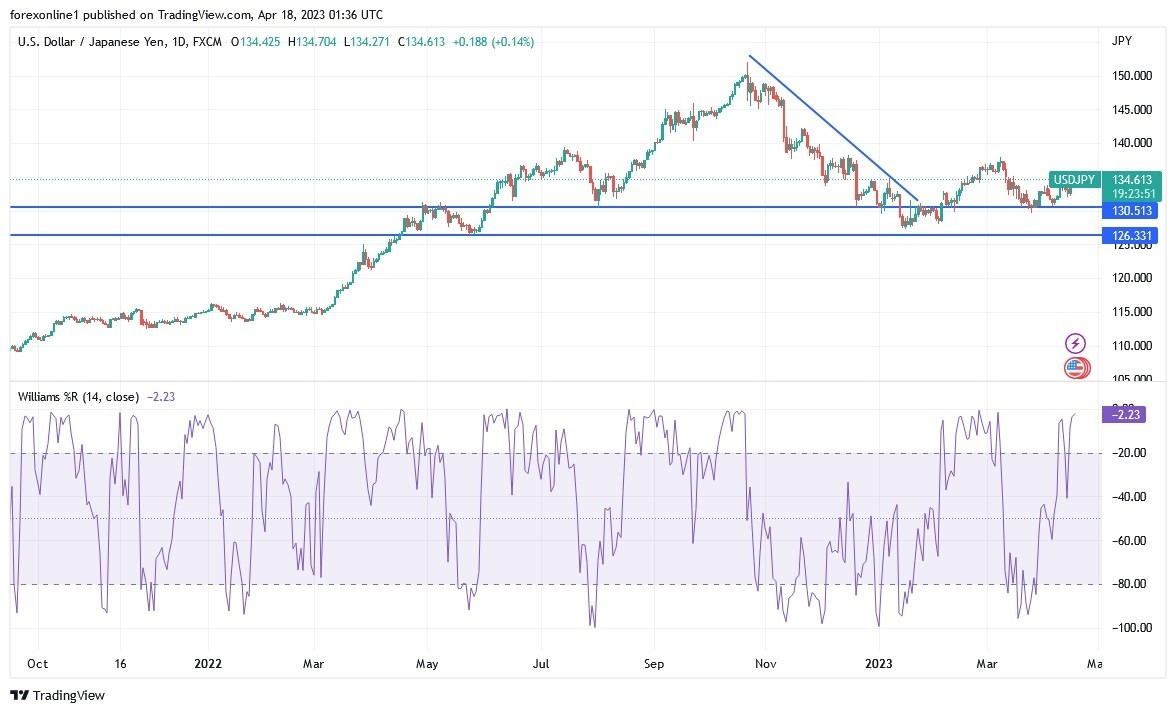- For three consecutive trading sessions, the price of the USD/JPY currency pair has been moving in the midst of a rebound to the upside, and the gains from that extended to the resistance level of 134.70, which is stable near its at the time of writing the analysis, waiting for more stimulus to complete the rebound.
- In general, recession fears escalated after US retail sales figures on Friday indicated a slowdown in consumer demand in the world's largest economy.
- Core retail sales fell worse than expected - 1.0% in March compared to February. Much of the decline was attributed to lower gasoline prices and lower auto sales, but even a closely watched core control group metric, which strips out all volatile components, fell in March.
US industrial production also contracted more than expected during this period, in another warning sign of weak growth. However, in both cases, the previous month's numbers were revised upwards, and it appears that the data wasn't bad enough to cause Fed policymakers to worry. Consumers were likely to be more cautious in March when the banking sector was under pressure and there was a flight of deposits. All indications point to a return of calm, not only within the banking system but also among consumers.
The measure of US consumer confidence at the University of Michigan rose in the preliminary reading for the month of April. More importantly, the survey's measure of consumer expectations for one-year inflation jumped from 3.6% to 4.6%. The sudden rise in inflation expectations came after a steady decline in recent months, underlining the need for the US Federal Reserve not to take its eyes off the ball.
Federal Reserve Governor Christopher Waller acknowledged on Friday that the US central bank had not made much progress in bringing inflation back to target, warning that "monetary policy needs to tighten further." Atlanta Fed Chairman Rafael Bostick took a somewhat more moderate tone, suggesting an additional quarter-point hike. But this was not enough to calm the markets as Waller stressed that policy must remain tight for "a significant period of time, and for a period longer than the markets expect."
Expectations of a US rate hike for the next meeting in May have tightened in the aftermath, with investors currently anticipating more than 80% of the possibility of a 25 basis point increase. What is worth noting, however, is that expectations for interest rate cuts fell by about 20 basis points after Waller's comments, in a kind of reality checks for the markets.
However, while Wall Street ended Friday lower, there were no signs of carnage in stock markets, as the S&P 500 closed down just 0.2%. Indeed, US futures are trading higher on Monday and European indices started the week with solid gains.
Banking giants Citigroup, JPMorgan Chase, and Wells Fargo reported better-than-expected earnings on Friday. Smaller regional banks haven't gotten off to a strong start like PNC Financial, which issued disappointing guidance for 2023. Bank of America and Goldman Sachs are both due to report Tuesday, but tech earnings are likely to steal the spotlight this week as financial results are due. for Netflix tomorrow as well, while Tesla will post its earnings on Wednesday.
Since the US economy is likely to slow further, it is difficult to explain some of the valuations on Wall Street now. It appears that investors are still putting their money into easing financial conditions sometime in the second half of this year, and the risk is what will happen if the Fed sticks to its word and keeps interest rates high through 2024.
It seems that forex traders are at least heeding the Fed's message as the US dollar rose about 0.5% against a basket of currencies on Friday and extended gains today. The 10-year Treasury yield rose to a two-week high and this could keep the dollar supported in a week where there is a barrage of inflation data released from other countries, including the UK and Canada.
USD/JPY Technical Outlook:
According to the performance on the daily chart below, the price of the USD/JPY currency pair is still at the beginning of an ascending channel that lacks more stimulus to confirm the bullish shift, and this requires a rebound toward the resistance levels of 145.40 and 147.30, respectively.
On the other hand, and for the same period of time, the return of the currency pair to the vicinity of the support level 132.20 will be important for the return of the bears' control over the trend. I still prefer to buy the currency pair from every downward level.

Ready to trade our daily Forex analysis? We’ve made a list of the best Forex brokers worth trading with.
